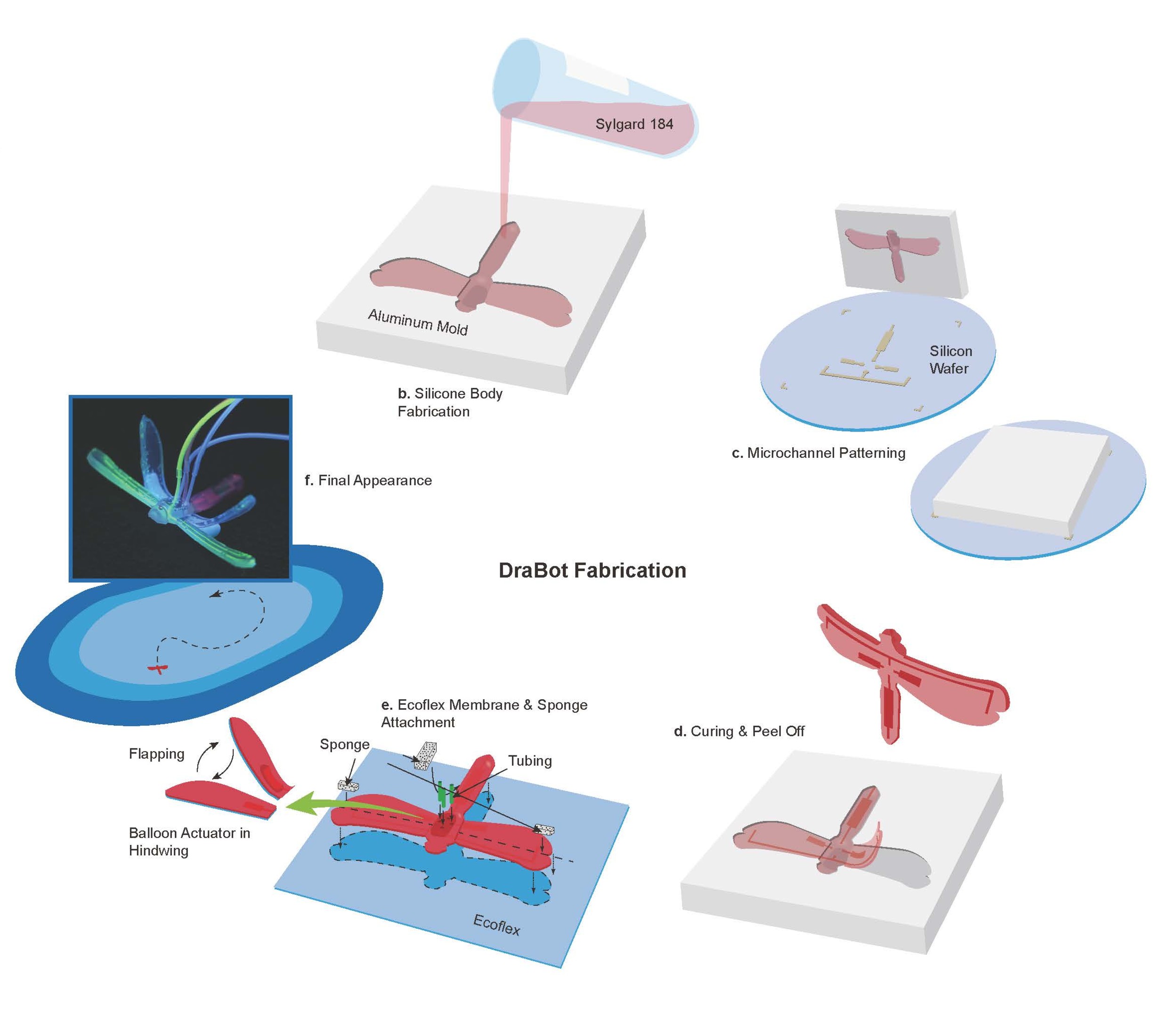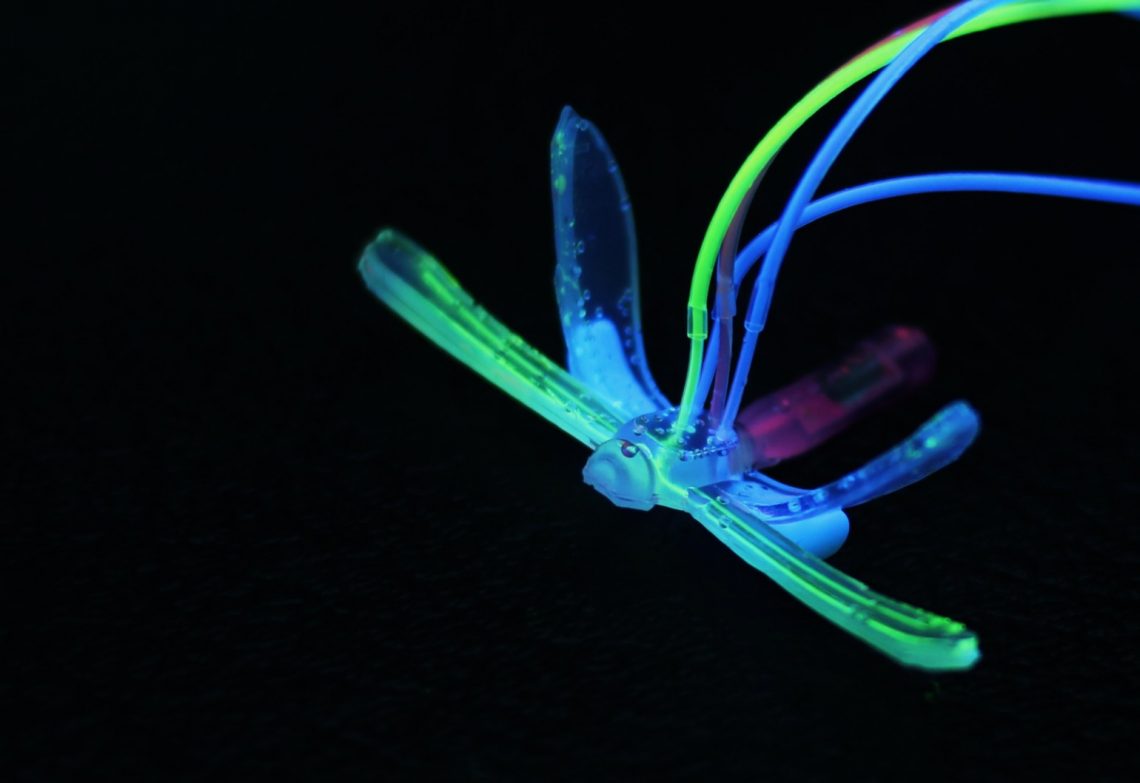Engineers in the US have developed an electronics-free robotic dragonfly that can detect impurities in water.
The soft robot, called ‘DraBot’, skims across water surfaces and reacts to environmental conditions such as acidity, fluctuations in temperature and the presence of hydrophobic impurities.
DraBot is the creation of Duke University Professor of Biomedical Engineering, Mechanical Engineering and Materials Science and Orthopaedics Surgery Shyni Varghese and her team.
“Our research focuses on smart materials such as stimuli responsive and self-healing hydrogels,” Varghese told create. “We wanted to demonstrate the potential applications for these materials.”
The team originally designed DraBot based on a fly, but after several iterations settled on the shape of a dragonfly instead.
“We were designing a skimming robot and skimmers are the most common family of dragonflies,” Varghese said.
The silicone skimmer
Getting DraBot to skim where the researchers wanted it to wasn’t exactly a smooth process.
“Precise user-control over a robot’s speed and direction of motion is usually enabled by means of an electronic circuit. Achieving the same with only microfluidic and pneumatic circuits within a soft body was certainly a big challenge,” Varghese said.
“Other challenges involved getting the robot to its current dimension so that it maintains its balance during its functioning and incorporating multiple stimuli-responsive material-based sensors within its body.”
As a soft robot, the DraBot was built by baking silicone in an aluminium mould. It is only 57 mm long with a wing span of 35 mm.

The robot moves by pumping air through flexible tubes, which escape through a series of holes pointed at the dragonfly’s back wings. For additional control, a balloon beneath each back wing can cause the wings to move up or down and change direction accordingly.
“In general, soft materials help robots squeeze into tight spaces and carry out delicate tasks, or apply force gently to handle fragile objects. These capabilities are hard to achieve using rigid materials,” Varghese said.
“Since the hydrogels themselves are soft materials and we have worked with stimuli responsive hydrogels, it was rather obvious for us to integrate it within a soft robot.”
The substance Varghese refers to is a self-healing hydrogel of her own invention. The self-healing hydrogels can create physical bonds among two pieces of hydrogels when it detects a low pH. The bond dissolves when the pH returns to normal levels.
One set of DraBot’s wings are painted with the hydrogel, so if the robot comes into contact with acidic water the wings stick together, causing it to fly in circles.
DraBot’s wings are designed to detect the changes in water temperature.. The wings are also covered with a thermochromic pigment, which changes colour from red to yellow if the robot detects an increase in water temperature.
Flying into the future
DraBot was built as a proof-of-principle, but its detection abilities could help with a number of environmental issues.
For example, the ability to absorb hydrophobic impurities could help with the early detection of oil spills. While its colour-changing wings may help show signs of coral bleaching or red tide — the proliferation of harmful algae along coastal shores.
To get to that point, Varghese would like to set DraBot free of it’s tubing, enabling it to move cordlessly.
“Future iterations of DraBot might incorporate an on-board propellant reservoir,” she said.
“Currently, we have supplied propellants using soft tubings, which help with retrievability of the robot but can also entangle in very long runs.”
It’s possible future versions could be propelled by a kind of chemical reactions or synthetic biology that generates energy. “We are still discussing these options,” Varghese added.
Varghese and her team also hope that DraBot’s remit could expand in the future.
“DraBot certainly has the potential to pave the way for more advanced environmental probes,” Varghese said.
“While DraBot was engineered with capabilities to detect chemicals and temperature changes, addition of biological sensors could help detect pathogens of water-borne diseases.”
Varghese believes DraBot could inspire future soft robots.
“The design strategies [of DraBot] are also transferrable to other fields, such as medical,” she said.
“In cases where incorporation of rigid materials within robots is absolutely necessary, soft actuators and sensors could be integrated into some parts to create a hybrid hard-soft robot. For example a metallic robot with soft hands.”



